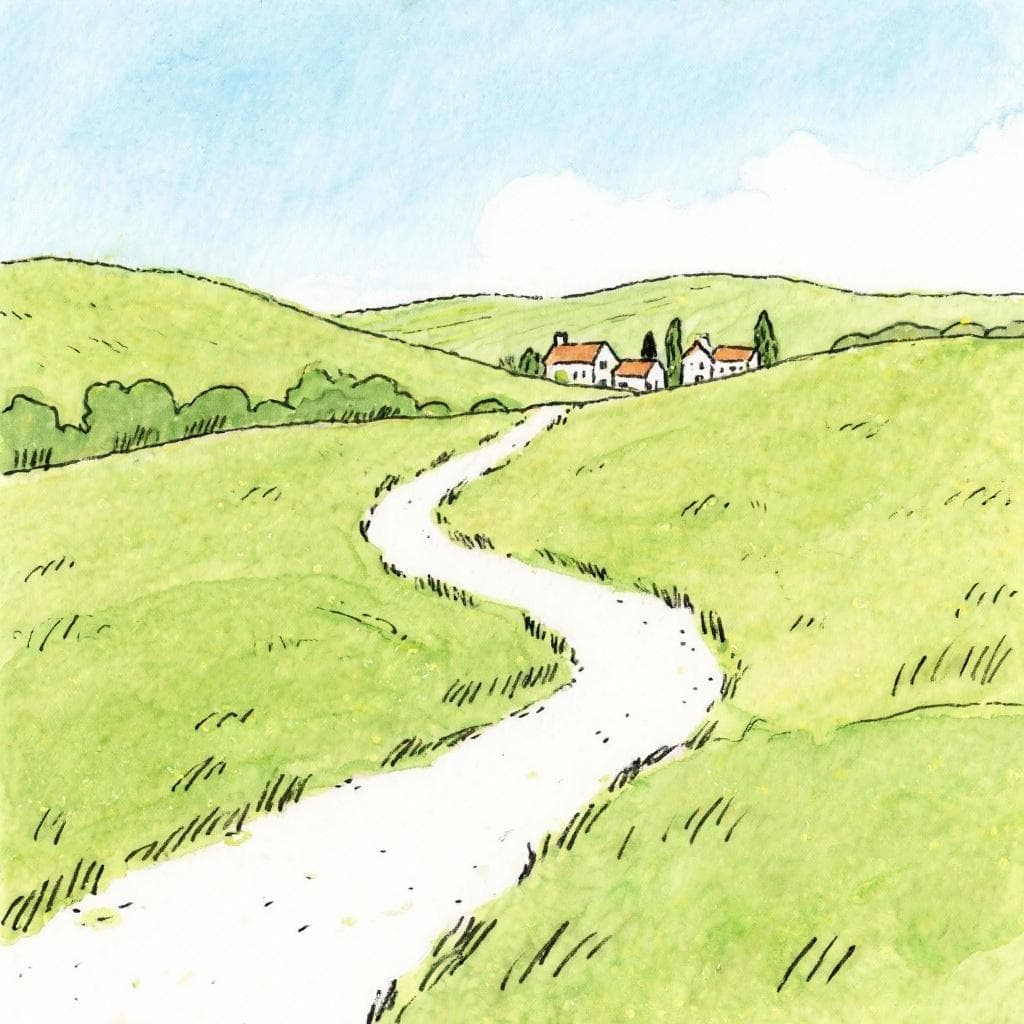Table of Contents
The Spanish Imperfect Tense: A Complete Guide to Describing the Past
Ever wanted to tell a story about your childhood in Spanish? Describe what your old neighborhood was like, what you used to do every summer, or what was happening when something surprising occurred? If so, you’re in the right place!
Welcome to your complete guide to the Spanish Imperfect Tense, or el pretérito imperfecto.
Think of the past as a movie. Some actions are the main plot points: the hero arrived, he fought the dragon, he saved the day. That's another tense called the preterite.
The imperfect tense, however, is the scenery, the background music, and the character descriptions. It's the "wavy-lined flashback" tense. It describes what was happening, what things were like, and what you used to do. It’s the key to making your stories about the past come alive.

In this guide, we'll unlock the magic of the imperfect, covering:
- What it is and why it's different from the preterite.
- How to form it (good news: it’s one of the easiest tenses!).
- Exactly when to use it with a handy acronym.
- Practice exercises to make it stick.
Let's dive in and become past-tense storytellers!
How to Form the Imperfect Tense
One of the best things about the imperfect is how regular it is. Once you learn the patterns for -AR, -ER, and -IR verbs, you're 90% of the way there.
Regular -AR Verbs
For regular -AR verbs, you simply drop the -AR and add one of these endings: -aba, -abas, -aba, -ábamos, -abais, -aban.
Notice that the yo and the él/ella/usted forms are the same! Context will always tell you who is doing the action.
Let's see it with caminarto walk:
| Pronoun | Ending | Example: caminar |
|---|---|---|
| yo | -aba | caminaba (I was walking / I used to walk) |
| tú | -abas | caminabas (You were walking / you used to walk) |
| él/ella/Ud. | -aba | caminaba (He/she was walking / used to walk) |
| nosotros/as | -ábamos | caminábamos (We were walking / we used to walk) |
| vosotros/as | -abais | caminabais (You all were walking / used to walk) |
| ellos/ellas/Uds. | -aban | caminaban (They were walking / used to walk) |
Example Sentence:
CuandoWhen eraI was niñoa child, caminabaI used to walk a la escuelaschool todos los díasevery day. (When I was a child, I used to walk to school every day.)
Regular -ER and -IR Verbs
Even better news! -ER and -IR verbs share the exact same set of endings in the imperfect. Just drop the -ER or -IR and add: -ía, -ías, -ía, -íamos, -íais, -ían.
Watch out for the accent!
Every single ending for -ER and -IR verbs in the imperfect has an accent mark on the first "i" (-ía). This is important for pronunciation!
Let's look at comerto eat (-ER) and vivirto live (-IR):
| Pronoun | Ending | Example: comer | Example: vivir |
|---|---|---|---|
| yo | -ía | comía (I was eating / I used to eat) | vivía (I was living / I used to live) |
| tú | -ías | comías (You were eating / used to eat) | vivías (You were living / used to live) |
| él/ella/Ud. | -ía | comía (He/she was eating / used to eat) | vivía (He/she was living / used to live) |
| nosotros/as | -íamos | comíamos (We were eating / used to eat) | vivíamos (We were living / used to live) |
| vosotros/as | -íais | vivíais (You all were living / used to live) | comíais (You all were eating / used to live) |
| ellos/ellas/Uds. | -ían | comían (They were eating / used to eat) | vivían (They were living / used to live) |
Example Sentences:
De pequeñossmall, comíamoswe used to eat muchosa lot of dulcessweets. (When we were little, we used to eat a lot of sweets.)
Mis abuelosgrandparents vivíanused to live en el campothe countryside. (My grandparents used to live in the countryside.)
How do you say 'you used to write' (tú form) in Spanish?
The Three (and only three!) Irregular Verbs
You read that right. In a world of tricky Spanish grammar, the imperfect tense is a gift. There are only three irregular verbs. Let's meet them.

Easy to Remember!
The three irregular verbs in the imperfect are ser (to be), ir (to go), and ver (to see). That's it! Every other verb follows the regular patterns above.
1. Ser (to be)
Used for descriptions, characteristics, professions, and identity in the past.
| Pronoun | Conjugation |
|---|---|
| yo | era |
| tú | eras |
| él/ella/Ud. | era |
| nosotros/as | éramos |
| vosotros/as | erais |
| ellos/ellas/Uds. | eran |
Mi padrefather era médicoa doctor. (My father was a doctor.) Nosotros éramos muy buenosvery good amigosfriends. (We were very good friends.)
2. Ir (to go)
Used for talking about places you used to go.
| Pronoun | Conjugation |
|---|---|
| yo | iba |
| tú | ibas |
| él/ella/Ud. | iba |
| nosotros/as | íbamos |
| vosotros/as | ibais |
| ellos/ellas/Uds. | iban |
Cada veranosummer, mi familiafamily iba a la playabeach. (Every summer, my family would go to the beach.) ¿Adónde ibas despuésafter de las clasesclasses? (Where did you use to go after classes?)
3. Ver (to see)
Used for things you used to see or watch.
| Pronoun | Conjugation |
|---|---|
| yo | veía |
| tú | veías |
| él/ella/Ud. | veía |
| nosotros/as | veíamos |
| vosotros/as | veíais |
| ellos/ellas/Uds. | veían |
Yo veía dibujos animadoscartoons los sábadosSaturdays por la mañanamorning. (I used to watch cartoons on Saturday mornings.) Desde mi ventanawindow, veía los árbolestrees. (From my window, I could see the trees.)
When to Use the Imperfect Tense: The "WATER" Rule
Okay, you know how to form the imperfect. But the big question is when to use it, especially when the preterite also exists.

To make it easy, remember the acronym WATER. You use the imperfect to talk about:
- Weather
- Age
- Time
- Emotions & Feelings
- Repetitive Actions & Descriptions
Let's break it down.
W: Weather
When you describe the weather in the past, you're setting a scene. It wasn't sunny for just one second; it was a condition.
- Hacía solsun y hacía calorheat. (It was sunny and hot.)
- Llovía muchoa lot en esathat ciudadcity. (It used to rain a lot in that city.)
A: Age
When you state someone's age in the past, you always use the imperfect form of tenerto have.
- Cuando tenía diez añosyears, aprendíI learned a montarto ride en bicibicycle. (When I was ten years old, I learned to ride a bike.)
- Mi hermanasister tenía cinco añosyears en esa fotothat photo. (My sister was five in that photo.)
T: Time
Telling time in the past also uses the imperfect. You'll use era for one o'clock and eran for all other hours.
- Era la una de la tardeafternoon cuando el teléfonophone sonórang. (It was one in the afternoon when the phone rang.)
- Eran las diez de la nochenight y todavíastill no dormíaI was sleeping. (It was ten at night and I still wasn't sleeping.)
E: Emotions & Feelings
Describing how someone was feeling or what they were thinking is a classic use of the imperfect. These are internal states, not actions.
- Yo estaba muy contentohappy con la noticianews. (I was very happy with the news.)
- Ellos se sentían nerviososnervous antesbefore del examenexam. (They felt nervous before the exam.)
- Pensaba que la películamovie era aburridaboring. (I thought the movie was boring.)
R: Repetitive Actions & Descriptions
This is the big one! It covers two key areas:
1. Repetitive or Habitual Actions ("used to" / "would always") If you did something repeatedly in the past without a clear beginning or end, use the imperfect.
- De niñoa child, jugaba al fútbolsoccer con mis amigosfriends. (As a child, I used to play soccer with my friends.)
- Mi abuelagrandmother siempre nos preparaba galletascookies. (My grandmother would always prepare cookies for us.)
2. Descriptions (Setting the Scene) Describing people, places, and situations in the past. What were they like?
- La casahouse era grandegrande y tenía un jardíngarden preciosobeautiful. (The house was big and had a beautiful garden.)
- El hombreman llevaba un sombrerohat negroblack. (The man was wearing a black hat.)
Arrange the words to form a correct sentence:
Imperfect vs. Preterite: The Ultimate Showdown
This is often the trickiest part for learners. When do you use the imperfect, and when do you use its spiky, action-oriented cousin, the preterite?
Think of it this way:
| Imperfect (Wavy Lines) | Preterite (Single Dots) |
|---|---|
| Background Info: Describes the scene | Main Action: Moves the story forward |
| "Used to" or "would" do something | A specific, completed action |
| Ongoing action in the past ("was -ing") | An action that interrupts another |
| No clear beginning or end | A clear beginning and end |
| Descriptions, feelings, time, age, weather | Single events, chain of events |
Let’s see them in action together. The imperfect sets the scene, and the preterite provides the action.
Llovía (Imperfect: it was raining) y hacía (Imperfect: it was) fríocold. Yo leía (Imperfect: I was reading) un librobook en el sofásofa cuando de repentesuddenly, el timbredoorbell sonó (Preterite: rang).
See how it works? The rain, the cold, and the reading were all ongoing background details. The doorbell ringing was a single, completed event that interrupted the scene.
Drag the handle to compare
The difference here is subtle but important.
- Conocía a tu hermano. (I knew your brother.) This describes a state of knowing him over a period of time.
- Conocí a tu hermano. (I met your brother.) This describes the single event of meeting him for the first time.
Which tense fits best? 'Ayer, yo ___ a mi casa a las cinco.' (Yesterday, I arrived home at five.)
Let's Practice!
Time to put your knowledge to the test. Choose the correct imperfect form for each sentence.
Cuando éramos niños, nosotros (vivir) en un apartamento pequeño.
La princesa (ser) muy bonita y (tener) el pelo largo.
¿Qué programa (ver) tú en la tele todos los días?
You've Got This!
The imperfect tense is your key to becoming a better storyteller in Spanish. It adds color, depth, and context to your past narratives.
Remember the key takeaways:
- It's for descriptions and repeated actions.
- The endings are super regular: -aba for -AR verbs, and -ía for -ER/-IR verbs.
- There are only three irregulars: ser (era), ir (iba), and ver (veía).
- When in doubt, think WATER: Weather, Age, Time, Emotions, Repetitive actions/Descriptions.
It might feel a little strange at first, especially when comparing it to the preterite, but with practice, it will become second nature. Keep telling stories, keep describing your memories, and soon the imperfect will be your best friend. ¡Tú podías hacerlo! (See? You were able to do it!)